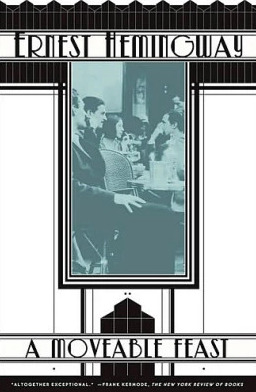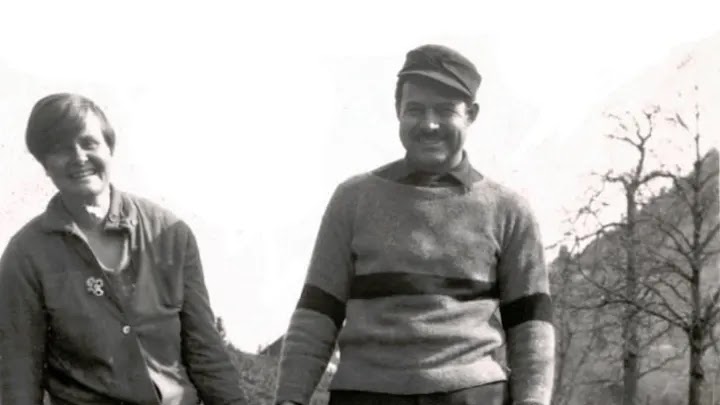Memory, like other intoxicants, has the power to delight, captivate, and leave a certain melancholy after the thrill goes away. That not-original notion came over me several times when reading A Moveable Feast, a collection of memories held dear by a famously unsentimental writer.
It must be said up front that of all Ernest Hemingway’s books, A Moveable Feast might be his most straight-up enjoyable. It combines his terse, declamatory style with a vibrant and at times colorful account of what it was like to live in Paris a century ago, when so much of our culture’s modern age was being formed.
Like In Our Time one of Hemingway’s most novelistic non-novels, A Moveable Feast’s narrative comes in the form of vignettes, each presenting a different aspect of the author’s time in Paris as a young writer. The end result is like popcorn to the Papa fan:
All the sadness of the city came suddenly with the first cold rains of winter, and there were no more tops to the high white houses as you walked but only the wet blackness of the street and the closed doors of the small shops, the herb sellers, the stationery and the newspaper shops, the midwife – second class – and the hotel where Verlaine had died where I had a room on the top floor where I worked.
That is from “A Good Café On The Place St.-Michel,” the opening essay where we see the author as a young writer plying his trade in the City of Light. As the book goes on, it captures other moments of Hemingway’s life with his first wife Hadley, namely the people they knew and the fun they had as a young couple with nothing to spend but love and time.
The theme of In Our Time is war and its aftermath, here it might be the power of memory. “Memory is hunger,” Hemingway quotes Hadley saying at one point. Here that voracious appetite becomes a desire to make the most of whatever happens and relive it on the page.
The hunger is also a physical one. Hemingway’s early success as a columnist and short-story writer did not translate into relative financial security until the publication in 1926 of The Sun Also Rises, Hemingway’s debut novel. The Hemingway we see here, pre-1926, is scrounging food, drink, and reading material from friends, including many famous ones on whom he dishes in unsparing detail.
Gertrude Stein is hospitable but quick-tempered, unable to handle Hemingway’s warm words regarding James Joyce because, as he puts it, “It was like mentioning one general favorably to another general.” Ezra Pound is good-hearted but too soft with friends. F. Scott Fitzgerald is talented but can handle neither strong drink nor his hard-headed wife. “Zelda wants to destroy you,” Hemingway recalls telling Fitzgerald.
Then there is British novelist Ford Madox Ford, who Hemingway treats as a kind of stuffy Colonel Blimp figure:
It was Ford Madox Ford, as he called himself then, and he was breathing heavily through a heavy, stained mustache and holding himself as upright as an ambulatory, well clothed, upended hogshead.
The one famous person to make it through A Moveable Feast unscathed is Hemingway himself. In his telling, he was never at a loss for the right thing to say, always careful with his temper, and deeply loving to Hadley and their son, Jack, nicknamed “Bumpy.”
Memory does work that way, doesn’t it? No wonder you can’t trust it.
A Moveable Feast was published three years after Hemingway’s death, which must have added to its elegiac tug. It is not a sad book, exactly, but it is wistful in its distinctively non-gushy way.
Much of the focus rests on Hemingway’s relationship with Hadley, whom Hemingway seems to regard in retrospect as the best part of those Paris days, enough to regret their separation caused by his success:
Those who attract people by their happiness and their performance are usually inexperienced. They do not know how not to be overrun and how to go away.
A Moveable Feast was largely put together post-mortem by Hemingway’s last wife, Mary, who demonstrates a grandness of spirit by allowing her predecessor to be so memorialized. There were two other wives between her and Hadley, including second wife Pauline, mentioned briefly here as an interloper who used her friendship with Hadley as a wedge to break up the marriage.
Apparently Hemingway wrote more scathingly of Pauline in his original manuscript, but Mary clipped that from the first edition. In 2009, a revised version of A Moveable Feast came out, with some excised material added back and other content removed instead. The result was a little too moveable for Hemingway purists, who called Feast just fine the first time, though with the author dead before it ever went to publication it was hard to know what would have made the final cut.
Given its tortured publication history, it is remarkable how well the book reads, and how positively it compares to the best non-fiction he produced in life, like Death In The Afternoon and Green Hills Of Africa. Feast covers a critical period in the author’s life and reads quite well, whatever the reader’s interest in Hemingway the person.
A Moveable Feast made a splash when it debuted, mainly for what it had to say about Fitzgerald, perhaps Hemingway’s closest thing to a recognized rival in the minds of 1964 readers. I never saw them as close enough in their writing style or interests to rate them against one another. Hemingway might have seen it differently.
In A Moveable Feast, Hemingway has fun with everything from Fitzgerald’s preoccupation with earnings to his insecurity about the size of his penis. (Hemingway takes him to the Louvre to reassure him about his manhood.) Basically, F. Scott is depicted as a bit of a sad sack under the thrall of an unbalanced, manipulative woman:
If he could write a book as fine as The Great Gatsby I was sure that he could write an even better one. I did not know Zelda yet, and so I did not know the terrible odds that were against him.
I found Hemingway’s digs at Fitzgerald’s output as a writer petty. The two men both produced their share of literary masterpieces, and Fitzgerald did so in a much shorter time. So when Hemingway suggests Fitzgerald only managed a couple of good books and some “fine” short stories, I bristled, though his intent may not have been to belittle.
Hemingway’s preoccupation with great writing and the demands it places on a craftsman struggling to become an artist was my biggest takeaway from A Moveable Feast. In his opening essay, Hemingway explains how he sat for hours at a café working on an unnamed short story, probably “The Three-Day Blow” from hints he gives, while eating oysters and looking over an attractive woman at another table. He describes how he felt taking her in:
I’ve seen you, beauty, and you belong to me now, whoever you are waiting for and if I never see you again, I thought. You belong to me and all Paris belongs to me and I belong to this notebook and this pencil.
In other places, Hemingway’s dedication to writing offers less satisfaction and more sweat. “Write the truest sentence that you know,” he explains. Fitzgerald’s writing style seemed to strike Hemingway as too detached and frivolous by contrast, although Hemingway had that attitude about most writers and artists.
Hemingway himself was always as serious as a heart attack, if more in other books. Here he offers up some unalloyed charms, and even some dry chuckles, as when he remembers being pelted with grocery items by a junkie going through withdrawal: “For a poet he threw a very accurate milk bottle.”
In another essay, he describes an artist who dallied with a pair of his most beautiful models at a café where he joked with Hemingway about sex. Later, Hemingway recalls, the man hung himself:
They say the seeds of what we do are in all of us, but it always seemed to me that in those who make jokes in life the seeds are covered with better soil and with a higher grade of manure.
There are moments of tedium in A Moveable Feast, such as a long account about his betting on horse races which helped keep Hemingway and Hadley afloat until his luck ran out. “When I stopped working on the races I was glad but it left an emptiness,” he writes.
Other items are mentioned only in frustratingly oblique form, like a final falling out with Gertrude Stein about an argument with her companion Alice B. Toklas, though Toklas is never mentioned by name, and details about this argument are not given. Many things are left unsaid, an element of Hemingway’s style not conducive to memoirs.
But what is expressed is vivid: A seedy café, fishermen working the Seine and a goatherd selling fresh milk on the street. His descriptions of food and drink are succulent enough to add calories by osmosis. Most of all, there is Hadley, a fine woman Hemingway was belatedly realizing had been the one woman for him all along.
“I wished I had died before I ever had loved anyone but her,” he recalls.
A Moveable Feast is not a legitimate Hemingway book in the same way as those he saw through to publication, but it is enjoyable and readable in a way not all of those earlier books are, uniquely warm, wistful, and sweet like the best memories of youth itself.






No comments:
Post a Comment